Javier Ferrando
Do I Know This Entity? Knowledge Awareness and Hallucinations in Language Models
Nov 21, 2024
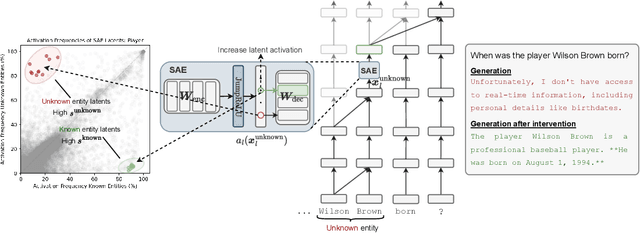


Abstract:Hallucinations in large language models are a widespread problem, yet the mechanisms behind whether models will hallucinate are poorly understood, limiting our ability to solve this problem. Using sparse autoencoders as an interpretability tool, we discover that a key part of these mechanisms is entity recognition, where the model detects if an entity is one it can recall facts about. Sparse autoencoders uncover meaningful directions in the representation space, these detect whether the model recognizes an entity, e.g. detecting it doesn't know about an athlete or a movie. This suggests that models can have self-knowledge: internal representations about their own capabilities. These directions are causally relevant: capable of steering the model to refuse to answer questions about known entities, or to hallucinate attributes of unknown entities when it would otherwise refuse. We demonstrate that despite the sparse autoencoders being trained on the base model, these directions have a causal effect on the chat model's refusal behavior, suggesting that chat finetuning has repurposed this existing mechanism. Furthermore, we provide an initial exploration into the mechanistic role of these directions in the model, finding that they disrupt the attention of downstream heads that typically move entity attributes to the final token.
On the Similarity of Circuits across Languages: a Case Study on the Subject-verb Agreement Task
Oct 09, 2024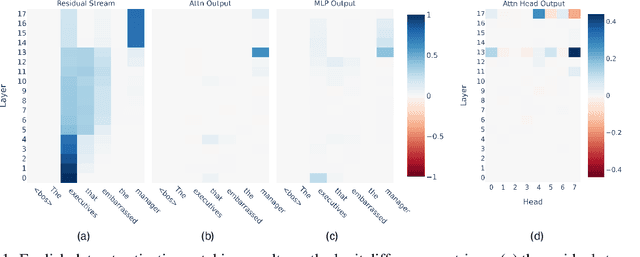
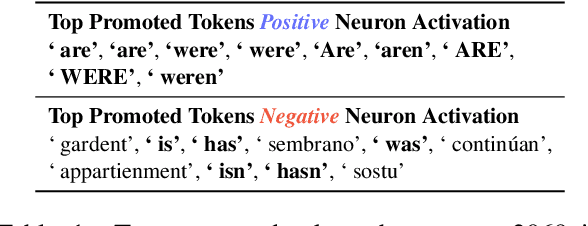
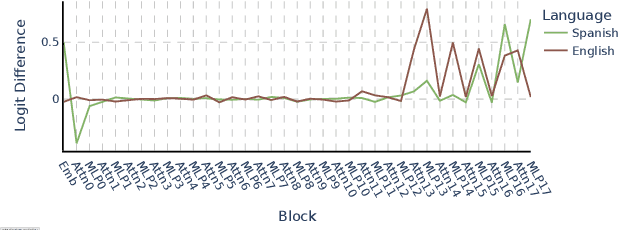

Abstract:Several algorithms implemented by language models have recently been successfully reversed-engineered. However, these findings have been concentrated on specific tasks and models, leaving it unclear how universal circuits are across different settings. In this paper, we study the circuits implemented by Gemma 2B for solving the subject-verb agreement task across two different languages, English and Spanish. We discover that both circuits are highly consistent, being mainly driven by a particular attention head writing a `subject number' signal to the last residual stream, which is read by a small set of neurons in the final MLPs. Notably, this subject number signal is represented as a direction in the residual stream space, and is language-independent. We demonstrate that this direction has a causal effect on the model predictions, effectively flipping the Spanish predicted verb number by intervening with the direction found in English. Finally, we present evidence of similar behavior in other models within the Gemma 1 and Gemma 2 families.
A Primer on the Inner Workings of Transformer-based Language Models
May 02, 2024Abstract:The rapid progress of research aimed at interpreting the inner workings of advanced language models has highlighted a need for contextualizing the insights gained from years of work in this area. This primer provides a concise technical introduction to the current techniques used to interpret the inner workings of Transformer-based language models, focusing on the generative decoder-only architecture. We conclude by presenting a comprehensive overview of the known internal mechanisms implemented by these models, uncovering connections across popular approaches and active research directions in this area.
LM Transparency Tool: Interactive Tool for Analyzing Transformer Language Models
Apr 10, 2024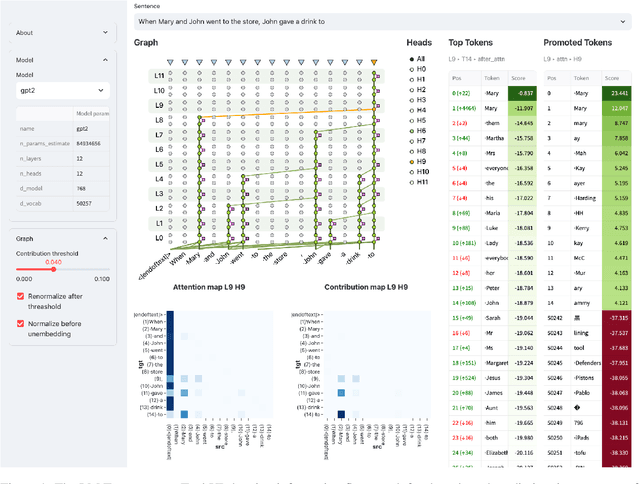
Abstract:We present the LM Transparency Tool (LM-TT), an open-source interactive toolkit for analyzing the internal workings of Transformer-based language models. Differently from previously existing tools that focus on isolated parts of the decision-making process, our framework is designed to make the entire prediction process transparent, and allows tracing back model behavior from the top-layer representation to very fine-grained parts of the model. Specifically, it (1) shows the important part of the whole input-to-output information flow, (2) allows attributing any changes done by a model block to individual attention heads and feed-forward neurons, (3) allows interpreting the functions of those heads or neurons. A crucial part of this pipeline is showing the importance of specific model components at each step. As a result, we are able to look at the roles of model components only in cases where they are important for a prediction. Since knowing which components should be inspected is key for analyzing large models where the number of these components is extremely high, we believe our tool will greatly support the interpretability community both in research settings and in practical applications.
Information Flow Routes: Automatically Interpreting Language Models at Scale
Feb 27, 2024Abstract:Information flows by routes inside the network via mechanisms implemented in the model. These routes can be represented as graphs where nodes correspond to token representations and edges to operations inside the network. We automatically build these graphs in a top-down manner, for each prediction leaving only the most important nodes and edges. In contrast to the existing workflows relying on activation patching, we do this through attribution: this allows us to efficiently uncover existing circuits with just a single forward pass. Additionally, the applicability of our method is far beyond patching: we do not need a human to carefully design prediction templates, and we can extract information flow routes for any prediction (not just the ones among the allowed templates). As a result, we can talk about model behavior in general, for specific types of predictions, or different domains. We experiment with Llama 2 and show that the role of some attention heads is overall important, e.g. previous token heads and subword merging heads. Next, we find similarities in Llama 2 behavior when handling tokens of the same part of speech. Finally, we show that some model components can be specialized on domains such as coding or multilingual texts.
Neurons in Large Language Models: Dead, N-gram, Positional
Sep 09, 2023Abstract:We analyze a family of large language models in such a lightweight manner that can be done on a single GPU. Specifically, we focus on the OPT family of models ranging from 125m to 66b parameters and rely only on whether an FFN neuron is activated or not. First, we find that the early part of the network is sparse and represents many discrete features. Here, many neurons (more than 70% in some layers of the 66b model) are "dead", i.e. they never activate on a large collection of diverse data. At the same time, many of the alive neurons are reserved for discrete features and act as token and n-gram detectors. Interestingly, their corresponding FFN updates not only promote next token candidates as could be expected, but also explicitly focus on removing the information about triggering them tokens, i.e., current input. To the best of our knowledge, this is the first example of mechanisms specialized at removing (rather than adding) information from the residual stream. With scale, models become more sparse in a sense that they have more dead neurons and token detectors. Finally, some neurons are positional: them being activated or not depends largely (or solely) on position and less so (or not at all) on textual data. We find that smaller models have sets of neurons acting as position range indicators while larger models operate in a less explicit manner.
Automating Behavioral Testing in Machine Translation
Sep 07, 2023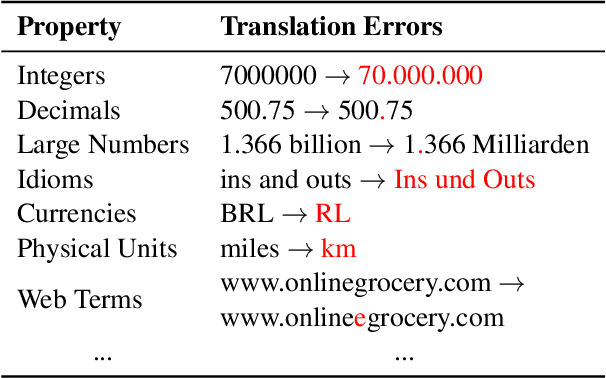



Abstract:Behavioral testing in NLP allows fine-grained evaluation of systems by examining their linguistic capabilities through the analysis of input-output behavior. Unfortunately, existing work on behavioral testing in Machine Translation (MT) is currently restricted to largely handcrafted tests covering a limited range of capabilities and languages. To address this limitation, we propose to use Large Language Models (LLMs) to generate a diverse set of source sentences tailored to test the behavior of MT models in a range of situations. We can then verify whether the MT model exhibits the expected behavior through matching candidate sets that are also generated using LLMs. Our approach aims to make behavioral testing of MT systems practical while requiring only minimal human effort. In our experiments, we apply our proposed evaluation framework to assess multiple available MT systems, revealing that while in general pass-rates follow the trends observable from traditional accuracy-based metrics, our method was able to uncover several important differences and potential bugs that go unnoticed when relying only on accuracy.
Explaining How Transformers Use Context to Build Predictions
May 21, 2023



Abstract:Language Generation Models produce words based on the previous context. Although existing methods offer input attributions as explanations for a model's prediction, it is still unclear how prior words affect the model's decision throughout the layers. In this work, we leverage recent advances in explainability of the Transformer and present a procedure to analyze models for language generation. Using contrastive examples, we compare the alignment of our explanations with evidence of the linguistic phenomena, and show that our method consistently aligns better than gradient-based and perturbation-based baselines. Then, we investigate the role of MLPs inside the Transformer and show that they learn features that help the model predict words that are grammatically acceptable. Lastly, we apply our method to Neural Machine Translation models, and demonstrate that they generate human-like source-target alignments for building predictions.
Toxicity in Multilingual Machine Translation at Scale
Oct 06, 2022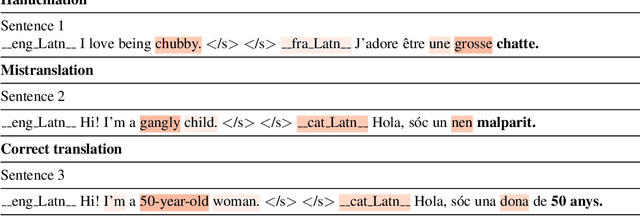

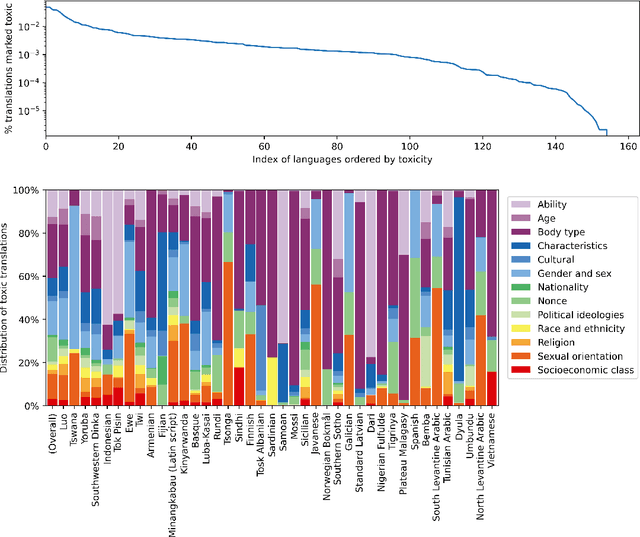
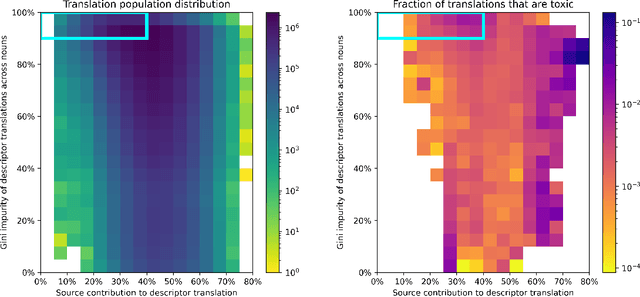
Abstract:Machine Translation systems can produce different types of errors, some of which get characterized as critical or catastrophic due to the specific negative impact they can have on users. Automatic or human evaluation metrics do not necessarily differentiate between such critical errors and more innocuous ones. In this paper we focus on one type of critical error: added toxicity. We evaluate and analyze added toxicity when translating a large evaluation dataset (HOLISTICBIAS, over 472k sentences, covering 13 demographic axes) from English into 164 languages. The toxicity automatic evaluation shows that added toxicity across languages varies from 0% to 5%. The output languages with the most added toxicity tend to be low-resource ones, and the demographic axes with the most added toxicity include sexual orientation, gender and sex, and ability. We also perform human evaluation on a subset of 8 directions, confirming the prevalence of true added toxicity. We use a measurement of the amount of source contribution to the translation, where a low source contribution implies hallucination, to interpret what causes toxicity. We observe that the source contribution is somewhat correlated with toxicity but that 45.6% of added toxic words have a high source contribution, suggesting that much of the added toxicity may be due to mistranslations. Combining the signal of source contribution level with a measurement of translation robustness allows us to flag 22.3% of added toxicity, suggesting that added toxicity may be related to both hallucination and the stability of translations in different contexts. Given these findings, our recommendations to reduce added toxicity are to curate training data to avoid mistranslations, mitigate hallucination and check unstable translations.
Towards Opening the Black Box of Neural Machine Translation: Source and Target Interpretations of the Transformer
May 23, 2022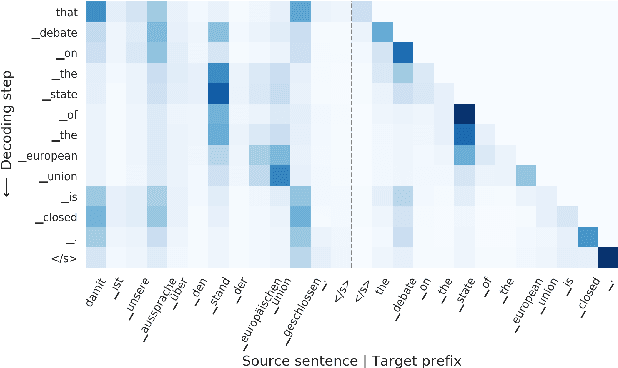
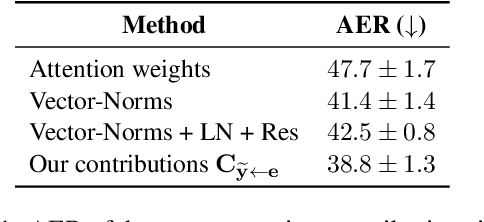
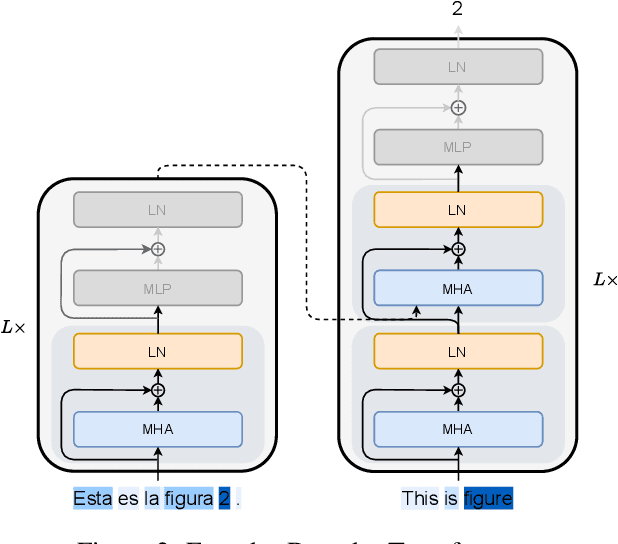
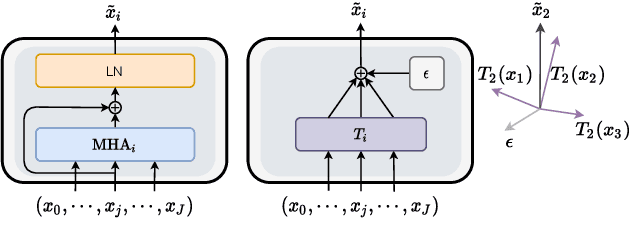
Abstract:In Neural Machine Translation (NMT), each token prediction is conditioned on the source sentence and the target prefix (what has been previously translated at a decoding step). However, previous work on interpretability in NMT has focused solely on source sentence tokens attributions. Therefore, we lack a full understanding of the influences of every input token (source sentence and target prefix) in the model predictions. In this work, we propose an interpretability method that tracks complete input token attributions. Our method, which can be extended to any encoder-decoder Transformer-based model, allows us to better comprehend the inner workings of current NMT models. We apply the proposed method to both bilingual and multilingual Transformers and present insights into their behaviour.
 Add to Chrome
Add to Chrome Add to Firefox
Add to Firefox Add to Edge
Add to Edge